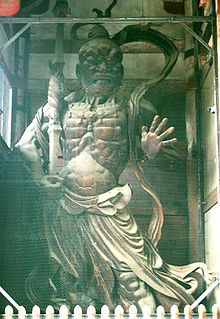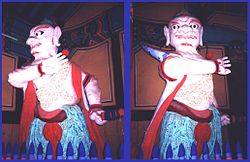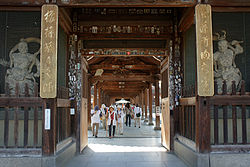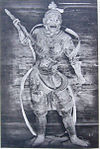- Nio
-
 A famous Japanese wooden Kongorikishi statue of Tōdai-ji, Nara (World Heritage Site). It was made by Busshi Unkei in 1203.
A famous Japanese wooden Kongorikishi statue of Tōdai-ji, Nara (World Heritage Site). It was made by Busshi Unkei in 1203.
Kongōrikishi (金剛力士) or Niō (仁王) are two wrath-filled and muscular guardians of the Buddha, standing today at the entrance of many Buddhist temples in China, Japan and Korea in the form of frightening wrestler-like statues. They are manifestations of the Bodhisattva Vajrapāṇi protector deity and are part of the Mahayana pantheon. According to Japanese tradition, they travelled with the historical Buddha to protect him. Within the generally pacifist traditions of Buddhism, stories of Niō guardians like Kongōrikishi justified the use of physical force to protect cherished values and beliefs against evil.
Contents
Manifestations
Kongōrikishi are usually a pair of figures that stand under a separate temple entrance gate usually called Niōmon (仁王門) in Japan, Heng Ha Er Jiang (哼哈二将) in China and Geumgangmun (金剛門) in Korea. The right statue is called Misshaku Kongō (密迹金剛) and has his mouth open, representing the vocalization of the first grapheme of Sanskrit Devanāgarī (अ) which is pronounced "a". The left statue is called Naraen Kongō (那羅延金剛) and has his mouth closed, representing the vocalization of the last grapheme of Devanāgarī (ह [ɦ]) which is pronounced "ɦūṃ" (हूँ). These two characters together symbolize the birth and death of all things. (Men are supposedly born speaking the "a" sound with mouths open and die speaking an "ɦūṃ" and mouths closed.) Similar to Alpha and Omega in Christianity, they signify "everything" or "all creation". The contraction of both is Aum (ॐ), which is Sanskrit for The Absolute.
Misshaku Kongō or Agyō
Misshaku Kongō (密迹金剛), also called Agyō (阿形) in Japanese, is a symbol of overt violence: he wields a vajra mallet "vajra-pāṇi" (a diamond club, thunderbolt stick, or sun symbol)[1] and bares his teeth. His mouth is depicted as being in the shape necessary to form the "ah" sound, leading to his alternate name, "Agyō". Misshaku Kongō (密迹金剛) is Miljeok geumgang in Korean, Mìjī jīngāng in Mandarin Chinese, and Mật tích kim cương in Vietnamese. It is equivalent to Guhyapāda vajra in Sanskrit.[2]
Naraen Kongō or Ungyō
 Narayeon Geumgang (Naraen Kongō) at Hwa-Eom Temple in South Korea.
Narayeon Geumgang (Naraen Kongō) at Hwa-Eom Temple in South Korea.
Naraen Kongō (那羅延金剛), also called Ungyō (吽形) in Japanese, is depicted either bare-handed or wielding a sword. He symbolizes latent strength, holding his mouth tightly shut. His mouth is rendered to form the sound "hūṃ" or "Un", leading to his alternate name "Ungyō". Naraen Kongō (那羅延金剛) is Narayeon geumgang in Korean, Nàluóyán jīngāng in Mandarin Chinese, and Na la diên kim cương in Vietnamese.[2]
Shukongōshin
A manifestation of Kongōrikishi that combines the Naraen and Misshaku Kongōs into one figure is the Shukongōshin at Tōdai-ji in Nara, Japan. Shukongōshin (執金剛神), literally "vajra-wielding spirit", is Shūkongōshin or Shikkongōjin in Japanese, Jip geumgang sin in Korean, Zhí jīngāng shén in Mandarin Chinese, and Chấp kim cang thần in Vietnamese.[2]
Hellenistic influence
Kongōrikishi are an interesting case of the possible transmission of the image of the Greek hero Heracles to East Asia along the Silk Road. Heracles was used in Greco-Buddhist art to represent Vajrapani, the protector of the Buddha (See also Image), and his representation was then used in China and Japan to depict the protector gods of Buddhist temples. This transmission is part of the wider Greco-Buddhist syncretic phenomenon, where Buddhism interacted with the Hellenistic culture of Central Asia from the 4th century BC to the 4th century AD.[3]
Iconographical evolution from the Greek Heracles to Shukongōshin. From left to right:
1) Herakles (Louvre Museum).
2) Heracles on coin of Greco-Bactrian king Demetrius I.
3 Vajrapani, the protector of the Buddha, depicted as Herakles in the Greco-Buddhist art of Gandhara.
4) Shukongōshin of Buddhist temples in Japan.Influence on Taoism
Nio were also introduced into Chinese Taoism as Heng Ha Er Jiang (哼哈二将). In Taoism novel Fengshen Yanyi, Zheng Lun and Chen Qi were finally appointed as the two deities.[4]
Modern influence
The Kiddy Grade characters Un-ou and A-ou are named for Ungyō and Agyō, respectively.
The Street Fighter characters Akuma and Gouken are based around Nio.
In chapter 74, Yotsuba takes picture of a man on the street whom she mistakes for a Nio.
See also
- Vajrapani
- Skanda
- Buddhist temples in Japan
- Korean Buddhism
- Buddhist art
- Greco-Buddhism
- Greco-Buddhist art
- Jaya-Vijaya
Notes
- ^ See "金剛" at William Edward Soothill and Lewis Hodous. A Dictionary of Chinese Buddhist Terms
- ^ a b c Transliterations from Digital Dictionary of Buddhism
- ^ "The origin of the image of Vajrapani should be explained. This deity is the protector and guide of the Buddha Sakyamuni. His image was modeled after that of Hercules. (...) The Gandharan Vajrapani was transformed in Central Asia and China and afterwards transmitted to Japan, where it exerted stylistic influences on the wrestler-like statues of the Guardian Deities (Nio)." (Katsumi Tanabe, "Alexander the Great, East-West cultural contacts from Greece to Japan", p23)
- ^ Fengshen Yanyi, chapter 99.
References
- Religions and the Silk Road by Richard C. Foltz (St. Martin's Press, 1999) ISBN 0-312-23338-8
- The Diffusion of Classical Art in Antiquity by John Boardman (Princeton University Press, 1994) ISBN 0-691-03680-2
- Old World Encounters. Cross-cultural contacts and exchanges in pre-modern times by Jerry H.Bentley (Oxford University Press, 1993) ISBN 0-19-507639-7
- Alexander the Great: East-West Cultural contacts from Greece to Japan (NHK and Tokyo National Museum, 2003)
External links
Buddhism Bodhisattvas General list Chinese Vajrayana Other Bhaishajyaraja · Candraprabha · Nagarjuna · Niō · Shantideva · Supratisthitacaritra · Supushpachandra · Suryaprabha · Vasudhara · VisistacaritraCategories:- Bodhisattvas
- Japanese gods
- Buddhism in Japan
- Buddhism in Korea
- Heracles
Wikimedia Foundation. 2010.



